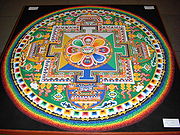
Unique hues
Encyclopedia

Opponent process
The color opponent process is a color theory that states that the human visual system interprets information about color by processing signals from cones and rods in an antagonistic manner...
theory of color
Color
Color or colour is the visual perceptual property corresponding in humans to the categories called red, green, blue and others. Color derives from the spectrum of light interacting in the eye with the spectral sensitivities of the light receptors...
, there are four unique hues – red
Red
Red is any of a number of similar colors evoked by light consisting predominantly of the longest wavelengths of light discernible by the human eye, in the wavelength range of roughly 630–740 nm. Longer wavelengths than this are called infrared , and cannot be seen by the naked eye...
, yellow
Yellow
Yellow is the color evoked by light that stimulates both the L and M cone cells of the retina about equally, with no significant stimulation of the S cone cells. Light with a wavelength of 570–590 nm is yellow, as is light with a suitable mixture of red and green...
, green
Green
Green is a color, the perception of which is evoked by light having a spectrum dominated by energy with a wavelength of roughly 520–570 nanometres. In the subtractive color system, it is not a primary color, but is created out of a mixture of yellow and blue, or yellow and cyan; it is considered...
, and blue
Blue
Blue is a colour, the perception of which is evoked by light having a spectrum dominated by energy with a wavelength of roughly 440–490 nm. It is considered one of the additive primary colours. On the HSV Colour Wheel, the complement of blue is yellow; that is, a colour corresponding to an equal...
– relative to which other hues are defined. Unique red is a red which appears to have no yellow or blue in it; unique yellow is a yellow which appears to have no red or green in it; etc.
Color names for these four colors are among the earliest defined in most languages.
Leonardo da Vinci
Leonardo da Vinci
Leonardo di ser Piero da Vinci was an Italian Renaissance polymath: painter, sculptor, architect, musician, scientist, mathematician, engineer, inventor, anatomist, geologist, cartographer, botanist and writer whose genius, perhaps more than that of any other figure, epitomized the Renaissance...
defined these four as the basic colors from which other colors should be mixed.
Hues chosen as unique vary somewhat from person to person, but several models have attempted to define a standard. The Swedish Natural Color System
Natural Color System
The Natural Color System is a proprietary perceptual color model published by the Scandinavian Colour Institute of Stockholm, Sweden. It is based on the color opponency description of color vision, first proposed by German physiologist Ewald Hering...
is the most widely used of these, placing red, yellow, green, and blue in cardinal hue directions. The recent CIECAM02
CIECAM02
Published in 2002 by the CIE Technical Committee 8-01 , as of 2008 CIECAM02 is the most recent color appearance model ratified by the CIE, and the successor of CIECAM97s.| quote=The CIECAM97s model was adopted by the CIE in 1997 for color imaging applications. It includes forward and reverse modes...
model defines red as h = 20.14° , yellow as h = 90° , green as h = 164.25° , and blue as h = 237.53° .

